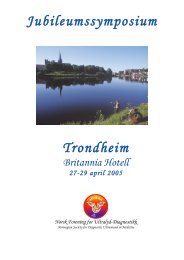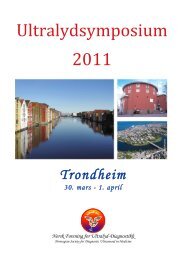Ultralydsymposium - NORSK FORENING FOR ULTRALYD ...
Ultralydsymposium - NORSK FORENING FOR ULTRALYD ...
Ultralydsymposium - NORSK FORENING FOR ULTRALYD ...
- No tags were found...
Create successful ePaper yourself
Turn your PDF publications into a flip-book with our unique Google optimized e-Paper software.
Frie foredragREDUCING ULTRASOUND REVERBERATION ARTIFACTS BYACTIVE IMPEDANCE MATCHING AND PARTICLE SWARMOPTIMIZATIONJ. Francisco Mainou G. 1, 2 , Tonni Franke J. 1, 31 Norwegian University of Science and Technology, Trondheim, Norway, 2 University of Bergen, Bergen,Norway, 3 Foundation for Scientific and Industrial Research at the Norwegian Institute of Technology,Trondheim, NorwayAim: To reduce the reflection coefficients on the ultrasound transducer surface by activeelectronics.Background: Reverberation is defined as equally-spaced, bright linear echoes resulting fromreflection from specular-type interfaces. They are provoked by the acoustic Impedancechange between the tissue and transducer front surface. B. Angelsen developed amathematical approach to correct this ultrasound artifact by coupling the ultrasoundtransducer with an ideal electrical load in order to obtain zero reflection coefficients on thetransducer from face [1]. However, when analyzing Impedance spectroscopy this approachcannot be achieved by using passive electronics in most simulated cases. Active impedancemay be seen as a trend to improve image quality. This research therefore implements andsimulates methods for active impedance synthesis [2] and applies Particle SwarmOptimization to the proposed electronics. Finally, the simulations are compared through aLAB experiment.Material, Methods and Results: “Z i ”, the electrical impedance of a specific transducer isSignal To Signal Ratio1.21.110.90.80.70.60.5X: 4e+006Y: 0.9379RLs PassiveRLo PassiveActive ElectronicsX: 4e+006Y: 1.058X: 4e+006Y: 0.90343 3.5 4 4.5simulated using X-Trans and Matlab software.Given Z i , the ideal electrical Impedance of thematching network called Z0 is calculated to cancelthe reverberation. The PSO algorithm is applied tothe total input impedance of passive and activeelectronics to approach Z0 and minimize thereflection coefficients. The simulation is testedwith a laboratory experiment where twotransducers face each other and the pulse echo ismeasured at transducer 1, amplitude is decreasedwhen adding the electronics to transducer 2, whichproves that the front face of the second transducerbecomes more absorptive due to the connectedfreq [Hz]load. The graph shows the signal-to-signal ratio, x 10 6the division of the power energy spectrum ofthe measured signals when transducer two is connected to the electronics and a referencesignal. This reference signal is the pulse echo when the same transducer 2 is not connected toa load. Because a reduction exists, the ratio is below to 1 on y-axis. X-axis is given in MHzand the simulated transducer has a central frequency of 4 MHz.Conclusions: Reduction of the Ultrasound Transducer surface reflection coefficient ispossible with active electronics. The general approach towards Impedance synthesis utilizes afilter design to affix the values of the Active impedance.References:1. ULTRASOUND IMAGING: Waves, Signals, and Signal Processing. Bjørn A. J. Angelsen,dr.techn. Copyright Dec 2000: Emantec, Norway2. SINTESIS DE REDES: Impedancias y Filtros. José Espí López, Gustavo Camps-Valls, RafaelMagdalena Benedito.











